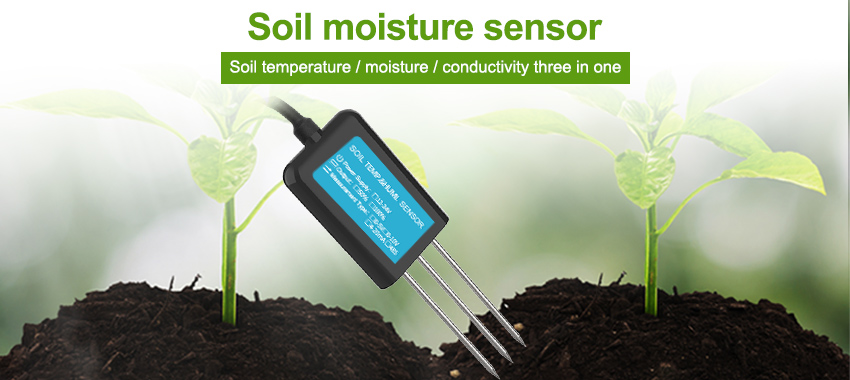The application of soil water sensor in irrigation scheduling is one of the most simple and effective methods to improve irrigation efficiency. Effective irrigation management can increase yields, improve food quality, conserve water and energy, and reduce nutrient leaching.

Soil water sensor measure or estimate the amount of water in the soil. These sensors can be stationary or portables such as handheld probes. Stationary sensors are placed at the predetermined locations and depths in the field, whereas portable soil moisture probes can measure soil moisture at several locations.
A better understanding of the basic principles, definitions, and terms behind the soil-water-plant relationship is essential to effectively utilize soil moisture sensors.

Soil water tension or matric potential sensors
Soil water tension indicates the energy required by plant roots to extract water from soil particles. As soil water is removed from soil, soil tension increases. Soil tension is expressed in centibars (cb) or bars of atmospheric pressure. When the soil is full of water, soil water tension is close to zero.
However, soil tension measurements are soil specific and can be inaccurate.Depending on your crop and soil observations, soil tension limits should be refined. For example, note the soil tension at the earliest indication of water stress and always make sure that you irrigate before it reaches that point.
Sensor installation and placement
Sensors should be placed at several different depths and locations in the field. Typically, sensors are placed in pairs at one-third and two-thirds the depth of the crop root zone and at two or more locations in the field, preferably in the representative soil type away from high points, depressions and slopes.
Some fields contain both heavy and light textured soils. In those fields, it is recommended that each soil type be monitored and managed separately for irrigation. Field mapping technologies can be used to identify different soil, such as electromagnetic conductivity (EM) mapping. By identifying different soils (different water holding capacities), management zones can be created that can be managed separately.
Where to place soil water sensor
- Place stationary sensors between plants within a crop row at their desired depths.
- Flag the sensors so field equipment operators can see where they are and prevent damage to them.
- Do not install the sensors close to the pivot wheel track and make sure that the sensor is in direct contact with soil and there is minimal soil disturbance during installation.
How to install soil water sensors
The method of installation is dependent upon the design of the sensor. Follow the installation instructions given by the manufacturer. In general, soil moisture sensor installation is done in one of two ways:
- By digging a hole or a trench and installing sensors horizontally at different depths or
- By using an auger or soil sampling probe to bore a hole and install sensors vertically.
Care must be taken when drilling the hole. Do not install the sensor in an oversize hole as it may cause voids and air gaps. To prevent air gaps, some users use a mixture of soil and water (soil slurry) during the installation; however, in many cases, the structure of the slurry does not match the surrounding soil, which may adversely affect the sensor reading.
магазин аккаунтов социальных сетей https://birzha-akkauntov-online.ru
профиль с подписчиками гарантия при продаже аккаунтов
безопасная сделка аккаунтов профиль с подписчиками
купить аккаунт гарантия при продаже аккаунтов
аккаунт для рекламы продать аккаунт
аккаунты с балансом магазин аккаунтов
продать аккаунт https://pokupka-akkauntov-online.ru/
Account Purchase Account exchange
Find Accounts for Sale Account Exchange Service
Buy and Sell Accounts Buy Pre-made Account
Secure Account Sales Accounts market
Buy and Sell Accounts Sell accounts
Marketplace for Ready-Made Accounts Database of Accounts for Sale
Online Account Store Account Purchase
Accounts market Guaranteed Accounts
Account Buying Service Verified Accounts for Sale
Account Store Account Trading Platform
buy and sell accounts account marketplace
online account store account selling service
account buying service account selling service
account trading service account selling platform
account trading service accounts for sale
account selling service profitable account sales
marketplace for ready-made accounts account trading platform
buy and sell accounts account buying service
purchase ready-made accounts account market
account exchange buy and sell accounts
account buying platform account sale
account trading platform social media account marketplace
accounts for sale secure account sales
gaming account marketplace profitable account sales
account trading platform ready-made accounts for sale
accounts for sale sell accounts
account market https://social-accounts-marketplace.org
sell accounts account selling platform
online account store account purchase
marketplace for ready-made accounts account exchange
find accounts for sale verified accounts for sale
buy and sell accounts account catalog
accounts for sale account exchange
buy accounts secure account sales
purchase ready-made accounts account selling platform
account exchange sell pre-made account
accounts for sale account purchase
account trading service https://accounts-offer.org/
sell pre-made account https://accounts-marketplace.xyz/
buy pre-made account https://buy-best-accounts.org
account trading platform https://social-accounts-marketplaces.live/
account exchange service https://accounts-marketplace.live
account market https://social-accounts-marketplace.xyz
account selling platform account marketplace
accounts marketplace https://buy-accounts-shop.pro
profitable account sales https://buy-accounts.live
account trading service https://accounts-marketplace.online
buy pre-made account https://social-accounts-marketplace.live/